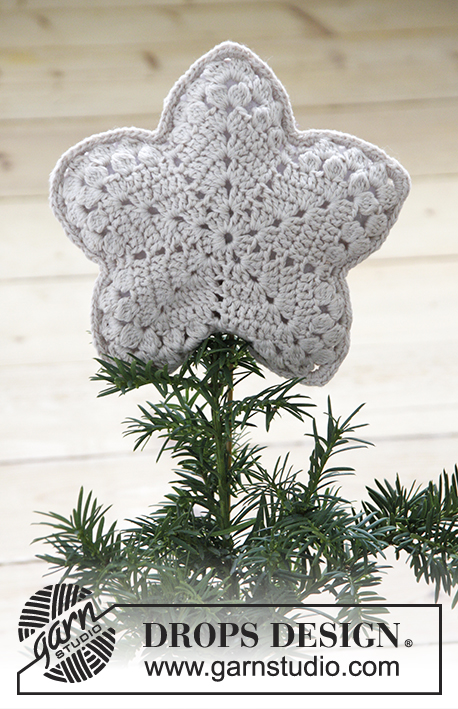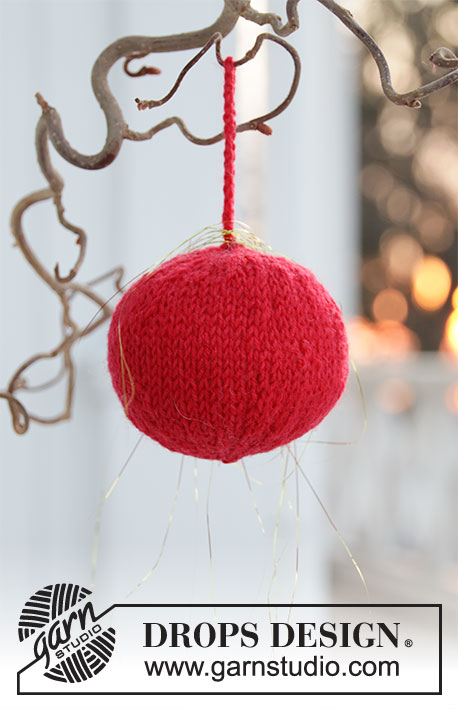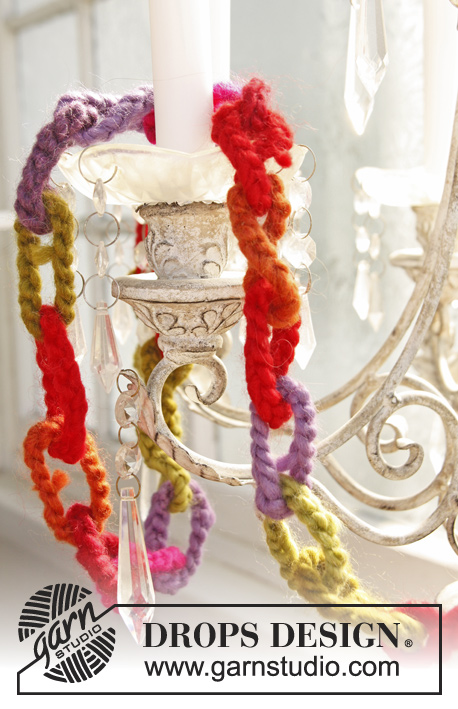Comments / Questions (6)
![]() Raffaella Gentile wrote:
Raffaella Gentile wrote:
Non si sente la voce della spiegazione, è sparita
25.11.2020 - 16:34DROPS Design answered:
Buonasera Raffaella, se fa riferimento al video, i nostri video non hanno audio, per permettere alle persone di diverse lingue di poterlo seguire, e hanno una spiegazione in tutte le lingue. Buon lavoro!
28.11.2020 - 21:23
![]() Maylin Lutz wrote:
Maylin Lutz wrote:
Hallo! Habe auch in der 6. Reihe glaube ich einen Fehler entdeckt, es fehlen gleich am Anfang 2 LM zwischen den ersten beiden Noppen. Am Schriftbild sind sie drauf, aber in der Textbeschreibung nicht.
02.11.2019 - 15:35DROPS Design answered:
Liebe Frau Lutz, danke für den Hinweis, deutsche Anleitung wird korrigiert. Viel Spaß beim häkeln!
05.11.2019 - 09:26
![]() Maylin Lutz wrote:
Maylin Lutz wrote:
Hallo! Bei der Anleitung zum Halter steht 6 LM anschlagen, zu einem Ring schließen, in jede LM eine FM, = 16 M. Da stimmt irgendetwas nicht, entweder schlage ich 16 LM an oder ich habe nur 6LM pro Reihe. Dem Foto in der Anleitung nach zur Urteilen ist der Halter recht breit, also müsste es wohl 16 LM anschlagen heißen.. Lg
02.11.2019 - 14:45DROPS Design answered:
Liebe Frau Lutz, es sollte 16 LM sein, deutsche Anleitung wird korrigiert. Viel Spaß beim häkeln!
04.11.2019 - 16:16
![]() Jeane Oliveira Da Silva wrote:
Jeane Oliveira Da Silva wrote:
Sou do Brazil gostaria de comprar os fios de vcs , mais nao entendo muito a lingua .
04.09.2019 - 14:00
![]() Dépinoy wrote:
Dépinoy wrote:
Je ne comprends pas très bien l'explication de la "housse" et de "l'étui"! Merci de bien vouloir m'éclairer à se sujet! Mylène
20.12.2015 - 20:52DROPS Design answered:
Bonjour Mme Dépinoy, les vidéos ci-dessous montrent comment réaliser l'étui et l'accrocher à l'étoile. Bon crochet!
21.12.2015 - 11:19
![]() Nina wrote:
Nina wrote:
Wow. Har verkligen väntat på ett bra mönster till toppstjärna.
17.12.2015 - 11:55
Top That! |
||||||||||||||||||||||||||||||||||
 |
 |
|||||||||||||||||||||||||||||||||
Crochet DROPS Christmas tree star with lace pattern in DROPS Belle. Theme: Christmas
DROPS Extra 0-1208 |
||||||||||||||||||||||||||||||||||
|
PATTERN: See diagrams A.1 and A.2. Diagram A.1 shows how round beg and ends. A.2 is repeated 4 times in total on round - NOTE: Last round is explained in pattern First round shows entire circle. CROCHET INFO -1: At beg of every tr round, replace first tr with 3 ch and finish round with 1 sl st in 3rd ch - NOTE: Work sl st around first ch-space/in first tr from previous round until first tr at beg of next round. CROCHET INFO-2: At beg of every dc round, replace first dc with 1 ch and finish round with 1 sl st in 1st ch and 1 sl st around first ch-space worked on next round. BOBBLE: Work 1 tr around ch-space/in tr but wait with last pull through (= 2 sts on hook), 4 tr around same ch-space/in same tr the same way, pull yarn through all 6 sts on hook. FILLING TIP: Fill star with cotton wool before crochet tog. Place some cotton wool on each side of holster so that it stands upright, and fill cotton wool out to tips. Holster should lay edge to edge with last round where stars where crochet tog. Use too much cotton wool rather than too little, excess cotton wool can be pulled out after crochet tog. ---------------------------------------------------------- TOP STAR: First work 1 interior holster, then 2 stars. Work all pieces tog on last round. Then fill top star with cotton wool. HOLSTER: Work 16 LOOSE ch on hook size 3.5 mm with Belle and form a ring with 1 sl st in first ch. Work 1 ch, 1 dc in every ch = 16 dc. Continue with 1 dc in every dc until piece measures approx. 10 cm. Fasten off. STAR: Work 6 ch on hook size 3.5 mm with Belle and form a ring with 1 sl st in first ch. Then work PATTERN - see explanation above - i.e. work as follows: ROUND 1: Work 5 ch (= 1 tr + 2 ch), * 3 tr around ch-ring, 2 ch *, repeat from *-* 4 times in total, 2 tr around ch-ring, finish round with 1 sl st in 3rd ch at beg of round and 1 sl st around first ch-space = 5 tr-groups and 5 ch-spaces. ROUND 2: READ CROCHET INFO-1. Work * 3 tr around first/next ch-space, 2 ch, 3 tr around same ch-space *, repeat from *-* 5 times in total = 10 tr-groups and 5 ch-spaces. ROUND 3: * Skip 1 tr, 1 tr in each of the next 2 tr, 3 tr around first/next ch-space, 2 ch, 3 tr around same ch-space, 1 tr in each of the next 2 tr, skip 1 tr *, repeat from *-*5 times in total = 50 tr and 5 ch-spaces. REMEMBER THE CROCHET TENSION! ROUND 4: * Skip 1 tr, 1 tr in each of the next 4 tr, 3 tr around first/next ch-space, 2 ch, 3 tr around same ch-space, 1 tr in each of the next 4 tr, skip 1 tr *, repeat from *-*5 times in total = 70 tr and 5 ch-spaces. ROUND 5: * Skip 1 tr, 1 tr in each of the next 6 tr, 3 tr around next ch-space, 2 ch, 3 tr around same ch-space, 1 tr in each of the next 6 tr, skip 1 tr *, repeat from *-*5 times in total = 90 tr and 5 ch-spaces. ROUND 6: READ CROCHET INFO-2. Work * 1 dc in first/next tr, 2 ch, skip 1 tr, 1 BOBBLE - see explanation above - in next tr, 2 ch, skip 2 tr, 1 bobble in next tr, 3 ch, skip 3 tr, 1 bobble around next ch-space, 4 ch, 1 bobble around same ch-space, 3 ch, skip 3 tr, 1 bobble in next tr, 2 ch, skip 2 tr, 1 bobble in next tr, 2 ch, skip 1 tr, 1 dc in next tr *, repeat from *-* 5 times in total = 30 bobbles, 35 ch-space and 10 dc. ROUND 7: Work * 1 dc around first/next ch-space, 2 ch, 1 bobble around next ch-space, 3 ch, 1 bobble around next ch-space, 3 ch, 1 bobble around next ch-space, 4 ch, 1 bobble around same ch-space, 3 ch, 1 bobble around next ch-space, 3 ch, 1 bobble around next ch-space, 2 ch, 1 dc around next ch-space, 2 ch *, repeat from *-* 5 times in total = 30 bobbles, 40 ch-spaces and 10 dc. Fasten off. Work 1 more star the same way. ASSEMBLY: Place the 2 stars tog WS against WS, place holster between these edge to edge - see last round in diagram A.1/A.2 (and symbol explanation for arrow) for placement - READ FILLING TIP, work as follows: ROUND 8: Fasten with 1 sl st in bobble, 1 ch, then work * 1 ch, 2 dc around each of the first/next 3 ch-spaces, 1 ch, 3 dc + 1 ch around each of the next 2 ch-spaces, 3 dc around next ch-space, 1 ch, 3 dc around same ch-space, 1 ch, 3 dc + 1 ch around each of the next 2 ch-spaces *, repeat from *-* 5 times in total, finish round with 1 sl st in first ch. Fasten off. Turn piece and work the same way on opposite side of holster and the other star, i.e. as follows: Fasten with 1 sl st in bobble, 1 ch, 2 dc around each of the first/next 3 ch-spaces, 1 ch, 1 sl st in bobble. Fasten off nicely in transitions. |
||||||||||||||||||||||||||||||||||
Diagram explanations |
||||||||||||||||||||||||||||||||||
|
||||||||||||||||||||||||||||||||||

|
||||||||||||||||||||||||||||||||||
Have you finished this pattern?Tag your pictures with #dropspattern or submit them to the #dropsfan gallery. Do you need help with this pattern?You'll find 10 tutorial videos, a Comments/Questions area and more by visiting the pattern on garnstudio.com. © 1982-2025 DROPS Design A/S. We reserve all rights. This document, including all its sub-sections, has copyrights. Read more about what you can do with our patterns at the bottom of each pattern on our site. |
||||||||||||||||||||||||||||||||||






















































Post a comment to pattern DROPS Extra 0-1208
We would love to hear what you have to say about this pattern!
If you want to leave a question, please make sure you select the correct category in the form below, to speed up the answering process. Required fields are marked *.